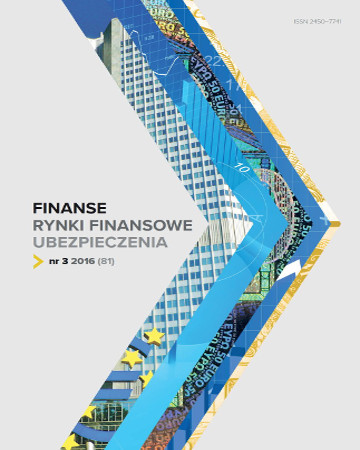
ISSN: 2450-7741
eISSN: 2300-4460
OAI
DOI: 10.18276/frfu.2016.4.82/2-32


Issue archive /
4/2016
Zasoby niematerialne i kapitał intelektualny a wartość przedsiębiorstwa
(Non-material Resources and Intellectual Capital as Elements of Enterprise’s Value)
| Authors: | Barbara Czerniachowicz |
| Keywords: | non-material resources intellectual capital the value of the company models of company value |
| Whole issue publication date: | 2016 |
| Page range: | 10 (373-382) |
Abstract
Management is a relatively new corporate issue brought into the workplace because of the changing conditions, structures, and marketplace priorities in every organisation. It stimulates creativeness, allows people to achieve higher results and moreover stimulates innovations and increases productivity. It also determines the kind of the decisions taken in the organisation, creates the culture of change and directs the future in the enterprise. The source of an enterprise’s advantage is its intellectual capital. One of the most important issues of intellectual capital is the difficulty in measuring it and presenting it in a financial statement to be able to demonstrate the role and its importance in building the value of a company. Companies treat expenditure incurred for the creation and development of elements of intellectual capital as a kind of long-term investment that brings measurable benefits, especially the creation of business units. However, only the coupling of human capital, internal and external structural capital, will allow the full potential of the organization and implementation of the strategic goal, which is creating enterprise value. The aim of the article is to present the essence of non-material resources, the concept of intellectual capital and the role of its components in the development of enterprise’s value. The study attempts to present the outlines of the structure of exemplary models taking into account the value of the enterprise’s non-material resources.
Download file
Article file
Bibliography
| 1. | Boulton R.E.S., Libert B.D., Samek S.M. (2001). Odczytując kod wartości. Jak firmy tworzą wartość w nowej gospodarce. Warszawa: WIG-Press. |
| 2. | Czerniachowicz B. (2011). Zasoby niematerialne w kształtowaniu wartości przedsiębiorstwa. Finanse, Rynki Finansowe, Ubezpieczenia, 37. |
| 3. | Czerniachowicz B., Marek S., Szczepkowska M. (2008). Zasoby i ich rola w działalności przedsiębiorstw, w: S. Marek (red.), Elementy nauki o przedsiębiorstwie. Szczecin: Economicus. |
| 4. | Edvinsson L., Malone M.S. (2001). Kapitał intelektualny. Warszawa: PWN. |
| 5. | Głuszek E. (2001). Wskaźnikowa metoda oceny kapitału intelektualnego przedsiębiorstwa, w: M. Moszkowicz (red.), Strategie i konkurencyjność przedsiębiorstw po dziesięciu latach transformacji. Polanica-Zdrój. |
| 6. | Głuszek E. (2004). Zarządzanie zasobami niematerialnymi przedsiębiorstwa. Wrocław: Wydawnictwo Akademii Ekonomicznej im. O. Langego. |
| 7. | Godziszewski B. (2001). Zasobowe uwarunkowania strategii przedsiębiorstwa. Toruń: Wydawnictwo Uniwersytetu im. M. Kopernika w Toruniu. |
| 8. | Jabłoński M., Jabłoński A. (2005). Kluczowe czynniki wartości firmy a jej rozwój. Controlling i rachunkowość zarządcza, nr 7, Warszawa: PWE. |
| 9. | Kaplan R.S., Norton D.P. (2001). Strategiczna karta wyników. Jak przełożyć strategię na działanie, Warszawa: Wydawnictwo Naukowe PWN. |
| 10. | Kaplan S.R. (2000). Spełniająca się strategia. Computerworld, 9. |
| 11. | Kuźnia K. (2008). Kapitał ludzki jako podstawa sukcesu nowoczesnego przedsiębiorstwa, w: G. Maniak (red.), Problemy ekonomii i polityki gospodarczej. Szczecin: Katedra Mikroekonomii Uniwersytetu Szczecińskiego. |
| 12. | Marcinkowska M. (2005). Kapitał intelektualny jako źródło przewagi konkurencyjnej współczesnej firmy, w: Wycena i zarządzanie wartością firmy (s. 61–66). Warszawa: Poltext. |
| 13. | Micha A. (2003). Przegląd koncepcji kapitału intelektualnego przedsiębiorstw, w: E. Urbańczyk (red.), Nowe tendencje w zarządzaniu wartością przedsiębiorstwa. Aktualny stan i perspektywy rozwoju. Szczecin: Kreos. |
| 14. | Pierścionek Z. (1996). Strategie rozwoju firmy. Warszawa: PWN. |
| 15. | Ross G., Ross J. (1997). Measuring your Company’s Intellectual Performance. Long Range Planning, June. |
| 16. | Ross J., Ross G., Dragonetti N.C., Edvinsson L. (1997). Intellectual Capital, Navigating the New Business Landscape. London: MacMillan Business. |
| 17. | Skoczylas W. (2007). Determinanty i modele wartości przedsiębiorstwa. Warszawa: PWE. |
| 18. | Strojny M. (2000). Zarządzanie kapitałem intelektualnym. Ogólny zarys koncepcji. Przegląd Organizacji, 7/8. |
| 19. | Sveiby K.E. (1997). The New Organizational Wealth: Managing & Measuring Knowledge – Based Assets. San Fransisco: Barret – Kohler Publishers,. |
| 20. | Urbanek G. (2008). Wycena aktywów niematerialnych przedsiębiorstwa. Warszawa: PWE. |
| 21. | Williams (1992). How sustainable is your competitive advantage?. California Management Review, 13. |